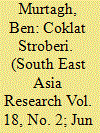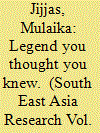|
|
|
Sort Order |
|
|
|
Items / Page
|
|
|
|
|
|
|
| Srl | Item |
| 1 |
ID:
097181


|
|
|
|
|
| Publication |
2010.
|
| Summary/Abstract |
This article focuses on the 2007 Indonesian film Coklat Stroberi and its accompanying novel and pop video. The novel by Christian Simamora was based on the film script. The song 'Di sini untukmu' was written especially for the film, in which the band Ungu made a cameo appearance, and the accompanying pop video features numerous scenes from it. While in recent years quite a number of Indonesian films have featured gay characters, this film is notable for the fact that it puts a gay relationship at the very centre of a romantic comedy, and is clearly aimed at a young (17-25) audience. Coklat Stroberi is undoubtedly trying to show same-sex relationships in a progressive light. Nonetheless, the representation of the characters and the film's final outcome highlight an ambivalent attitude towards homosexuality that is common in many Indonesian films. This article pays particular attention to those ambivalences and explores how our understanding of them is enhanced by analysing the transformation of the film into the genres of novel and pop video. Attention is also paid to an apparent mismatch in the filmic imagination of gay characters and the reality of gay lives as they are lived in Indonesia today.
|
|
|
|
|
|
|
|
|
|
|
|
|
|
|
|
| 2 |
ID:
097185


|
|
|
| 3 |
ID:
097184


|
|
|
|
|
| Publication |
2010.
|
| Summary/Abstract |
This paper discusses two adapted works of the Malay filmmaker U-Wei Haji Saari (b 1954): Kaki Bakar (The Arsonist, 1995), from William Faulkner's short story 'Barn Burning' and Buai Laju-Laju (Swing My Swing High, My Darling, 2004) from the novel by James M. Cain, The Postman Always Rings Twice. A close reading of these two films provides some insights into the filmmaker's thoughts on where Malay society is heading in terms of development, progress, social change and cultural values. The films focus on the tension between the individual and society, which is heightened by state capitalism and the drive for economic success. Along the way, each film deconstructs the notion of the achievement and success of the New Economic Policy (NEP, 1971-90) and suggests that men and women manage and manifest their existential anxieties differently. The author argues that Kaki Bakar and Buai Laju-Laju highlight oppositional dreams of individual versus collective Malay identity through movement and stasis, gendering stasis as traditional and male (Old Malay) and upward mobility as female (New Malay). Finally, Buai Laju-Laju's morally ambiguous ending, in which the femme fatale triumphs over the anti-hero, subtly comments on the social and moral costs of a state capitalist ideology that privileges developmentalism and materialism over human ethics.
|
|
|
|
|
|
|
|
|
|
|
|
|
|
|
|
| 4 |
ID:
097182


|
|
|
|
|
| Publication |
2010.
|
| Summary/Abstract |
This article traces the evolution of narratives about the supernatural woman said to live on Gunung Ledang, from oral folklore to sixteenth-century courtly texts to contemporary films. In all her instantiations, the figure of Puteri Gunung Ledang can be interpreted in relation to the legitimation of the state, with the folklore preserving her most archaic incarnation as a chthonic deity essential to the maintenance of the ruling dynasty. By the time of the Sejarah Melayu and Hikayat Hang Tuah, two of the most important classical texts of Malay literature, the myth of Puteri Gunung Ledang had been desacralized. Nevertheless, a vestigial sense of her importance to the sultanate of Melaka remains. The first Malaysian film that takes her as its subject, Puteri Gunung Ledang (S. Roomai Noor, 1961), is remarkably faithful to the style and substance of the traditional texts, even as it reworks the political message to suit its own time. The second film, Puteri Gunung Ledang (Saw Teong Hin, 2004), again exemplifies the ideology of its era, depoliticizing the source material even as it purveys Barisan Nasional ideology.
|
|
|
|
|
|
|
|
|
|
|
|
|
|
|
|
| 5 |
ID:
097183


|
|
|
|
|
| Publication |
2010.
|
| Summary/Abstract |
Filipino film adaptations have always been historically and culturally linked to theatre and comic art. However, the relationship between printed literature and film adaptations remains underexamined. In addition, works of literary journalism are not generally sourced for film translation. For this reason, Mike de Leon's Kisapmata (Split-Second, 1981), an adaptation of Quijano de Manila's 1961 work of reportage, 'The House on Zapote Street', published in the Philippines Free Press and republished in the anthology Reportage on Crime: Thirteen Horror Happenings that Hit the Headlines (1977, 2009) is a celebrated rarity in Philippine film history. This paper analyses the translation of 'The House on Zapote Street' from English-language reportage into a film that combines family drama, crime thriller and political allegory. It tackles how the difference in language used in the film version has reshaped the visuality of the translation. It also interprets the appropriation of the techniques of literary journalism, such as the treatment of time and space, dramatic reconstruction and status details, to the screen. The intention is to show how a piece of literary journalism can be transposed visually and to understand the cultural significance that can be derived from this process of visual transformation.
|
|
|
|
|
|
|
|
|
|
|
|
|
|
|
|
|
|
|
|
|